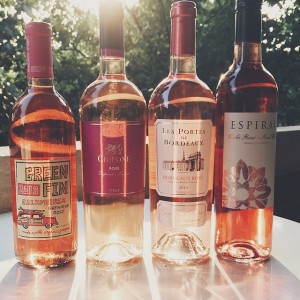They should be hanging out in your fridge,waiting to be enjoyed, because they’re delicious. Rosés are refreshing and perfect for summer and, though you might not already know it, they’re also pretty variable, just like red and white wine.
“But Meg,” you might say, “pink wine? That’s weird!”
Please. Don’t even talk to me about how it’s not cool to drink rosé. If you seriously think that you are missing out big time. I dare you to read on and tell me you’re not interested.
Contrary to popular belief, most rosé wine is not simply mixing red and white wines together. That’s like the swamp water way of making wine – no one does that!
There are four main methods of making rose wine, and the most common one is a method called maceration, which has to do with the length of time the wine spends with the grape skins.
- The least time = white wine
- The most time = red wine
- Somewhere in between = rosé wine
So really, rosés are like the Goldilocks of the wine world. And who doesn’t like Goldilocks? No one, that’s who.
Fun fact: You can make rosé out of any grape. This is one of the biggest reasons why I think rosés are so interesting. You think they’ll all be the same, but then you realize that since rosés can be made with red or white varietals, they’re as varied as red and white wines put together.
Mind = blown.
Generally speaking rosés work the same way whites and reds do when it comes to varietals. A rosé made from Cab Sauv grapes will be more full bodied and have a different flavour profile than one made from Pinot Noir grapes.
A good place to start when it comes to roses is France, especially Provence. Think about it – a little southern French town, everyone enjoying their summer by the sea, and what better way to enjoy it than with a glass of something that looks like the beautiful sunset in front of you?
My friend Cori jokes that any French rosé with a chicken on the label is a good pick, and I think she’s on to something. For an inexpensive (and French!) good time I usually go with what I call the La Vielle Ferme (note the label!), but this Famille Perrin Tavel is also a good bet. Tavel is a French wine Appellation (fancy word for a place certified for wine-growing) known for making great rosés.
If you want to veer away from the wine behemoth that is France I recommend travelling to Spain (at least in your glass) for some Muga rosé, or to Niagara for their Eastdell rosé. The Muga is lighter in body and flavour and the Eastdell is more full bodied, which you can also see in the saturation of colour – the Muga is a lighter pink and Eastdell is almost a strawberry shade of pinky red.
Cheap and cheerful, that’s what rosés are all about. Interested yet?




3 Comments
I think my assumption with a rose’ has always been that they’re too damn sweet for me. I don’t know why I’m left with that impression as I certainly haven’t had one in (quite possibly) a decade. Any recommendations for a dry one?
The French one I mention in the post is pretty dry (La Vieille Ferme) and some wines will make it super easy for you and actually say ‘dry’ right on the label, like this Cave Spring one. Both would be good options!
Thanks! I’ll give it a shot sometime. 🙂